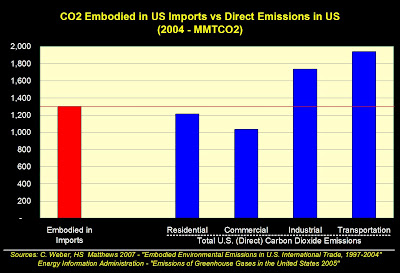Embodied carbon emissions in electronics even more...
Previously, I had done a back of the envelope calculation of the carbon emissions embodied in US imports, and together with Bin Shui, we had dug deeper to estimate the amount of carbon embodied in imports of electronics. Now, two academic papers (also using the eiolca.net dataset) present a more thorough analysis of the same issues and their numbers are staggering.
First, two Carnegie Mellon academics estimated the total amount of carbon embodied in US imports to be 1.3Gt. (That is the total amount of carbon emitted to produce the goods that we import and consumer in the US.) To put that in perspective, that is 22% of total CO2 emitted in the US, and more than all residential and more than all commercial emissions in the US. Below is a comparative chart, similar to the one we used in the VentureBeat article.

The other paper, co-written by the same academics, estimates the embodied emissions in imported electronic goods to be 470 MMT of CO2. To make the same kind of comparison as before, that is more than all of the local carbon emissions in the State of California.

As one of the co-authors said in a related news release:
_____________________
Note 1: Unfortunately, none of the above articles are available for free.
Note 2: The estimates in the second paper are much higher than those we had come up with in the VentureBeat article. This is partly because of different definitions of the electronics industry, but more importantly, it is because the paper adjusts for some additional factors to give a better estimate. At the time, we decided to keep our estimates pretty conservative, first because it would require a huge amount of work ;-) to refine the estimates, and second, because the numbers were pretty large already – so we felt that our conservative numbers should be enough to make our point.
First, two Carnegie Mellon academics estimated the total amount of carbon embodied in US imports to be 1.3Gt. (That is the total amount of carbon emitted to produce the goods that we import and consumer in the US.) To put that in perspective, that is 22% of total CO2 emitted in the US, and more than all residential and more than all commercial emissions in the US. Below is a comparative chart, similar to the one we used in the VentureBeat article.

The other paper, co-written by the same academics, estimates the embodied emissions in imported electronic goods to be 470 MMT of CO2. To make the same kind of comparison as before, that is more than all of the local carbon emissions in the State of California.

As one of the co-authors said in a related news release:
“The central question is one of responsibility. Over the last decade, the United States' share of global carbon emissions has gone down and China's has gone up. However, if you count not by who makes the goods, but by who consumes the goods, the United States' share of responsibility has stayed constant or even gone up. However, these emissions are not counted because they've been outsourced to other countries.”Environmentally conscious techies should really be paying more attention to these numbers!!
_____________________
Note 1: Unfortunately, none of the above articles are available for free.
Note 2: The estimates in the second paper are much higher than those we had come up with in the VentureBeat article. This is partly because of different definitions of the electronics industry, but more importantly, it is because the paper adjusts for some additional factors to give a better estimate. At the time, we decided to keep our estimates pretty conservative, first because it would require a huge amount of work ;-) to refine the estimates, and second, because the numbers were pretty large already – so we felt that our conservative numbers should be enough to make our point.

0 Comments:
Post a Comment
<< Home